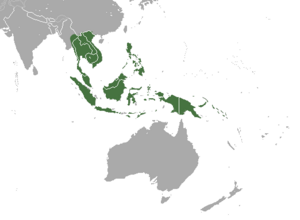Geoffroy's rousette facts for kids
Quick facts for kids Geoffroy's rousette |
|
|---|---|
| Conservation status | |
| Scientific classification | |
| Genus: |
Rousettus
|
| Species: |
amplexicaudatus
|
 |
|
| Geoffroy's Rousette range | |
The Geoffroy's rousette (Rousettus amplexicaudatus) is a type of megabat. These bats are also known as Old World fruit bats. It is one of ten different species in the Rousettus group.
Where Geoffroy's Rousettes Live
Geoffroy's rousettes can be found across Southeast Asia. They also live in the Malesia region of Oceania. You can find them in countries like Myanmar, Thailand, Cambodia, Laos, and Vietnam. They also live in Singapore, Indonesia, the island of Borneo, East Timor, and the Philippines. Further east, they are found in the Solomon Islands, the Bismarck Archipelago, and Papua New Guinea.
What Geoffroy's Rousettes Look Like
Like other fruit bats, Geoffroy's rousettes have excellent hearing and a strong sense of smell. They also have good eyesight. These senses help them fly well, especially at night. What makes this bat special is its ability to use echolocation. This means they make sounds and listen for the echoes to find their way around.
You can tell them apart by their fur. Their upper body is usually grey-brown to brown. The top of their head is darker, and their belly is paler, often grey-brown. They have long, light-colored hairs on their chin and neck. Sometimes, adult bats, especially males, have pale yellow fur tufts on the sides of their neck. Male Geoffroy's rousettes are often much bigger than females.
One unique thing about this bat is its wings. They are attached to the sides of its back. A wide band of fur separates the wings. These bats also make a clear, clicking sound that you can hear.
Life and Habits of the Bat
Geoffroy's rousettes usually live in caves. They like dark caves, cracks in rocks, and even old tombs. These medium-sized bats eat mostly fruit. They also feed on nectar and pollen from flowers.
The Monfort Bat Cave in the southern Philippines is home to the largest group of these bats. Thousands of Geoffroy's rousettes live there together.


